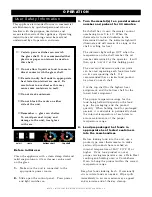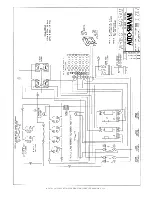
Chefs, cooks and other specialized food
service personnel employ varied methods of
cooking. Proper holding temperatures for a
specific food product must be based on the
moisture content of the product, product
density, volume, and proper serving
temperatures. Safe holding temperatures
must also be correlated with palatability in
determining the length of holding time for a
specific product.
Halo Heat maintains the maximum amount of
product moisture content without the addition
of water, water vapor, or steam. Maintaining
maximum natural product moisture preserves
the natural flavor of the product and provides
a more genuine taste. In addition to product
moisture retention, the gentle properties of
Halo Heat maintain a consistent temperature
throughout the cabinet without the necessity
of a heat distribution fan, thereby preventing
further moisture loss due to evaporation or
dehydration.
When product is removed from a high
temperature cooking environment for
immediate transfer into equipment with the
lower temperature required for hot food
holding, condensation can form on the outside
of the product and on the inside of plastic
containers used in self-service applications.
Allowing the product to release the initial
steam and heat produced by high temperature
cooking can alleviate this condition. To
preserve the safety and quality of freshly
cooked foods, however, a maximum of 1 to 2
minutes must be the only time period allowed
for the initial heat to be released from the
product.
Use a metal-stemmed thermometer to measure
the internal temperature of the product(s) being
held. Adjust the thermostat setting to achieve
the best overall setting based on internal product
temperature.
H O L D I N G T E M P E R A T U R E R A N G E
MEAT
FA H R E N H E I T
C E L S I U S
BEEF ROAST — Rare
140°F
60°C
BEEF ROAST — Med/Well Done
160°F
71°C
BEEF BRISKET
160° — 175°F
71° — 79°C
CORN BEEF
160° — 175°F
71° — 79°C
PASTRAMI
160° — 175°F
71° — 79°C
PRIME RIB — Rare
140°F
60°C
STEAKS — Broiled/Fried
140° — 160°F
60° — 71°C
RIBS — Beef or Pork
160°F
71°C
VEAL
160° — 175°F
71° — 79°C
HAM
160° — 175°F
71° — 79°C
PORK
160° — 175°F
71° — 79°C
LAMB
160° — 175°F
71° — 79°C
POULTRY
CHICKEN — Fried/Baked
160° — 175°F
71° — 79°C
DUCK
160° — 175°F
71° — 79°C
TURKEY
160° — 175°F
71° — 79°C
GENERAL
160° — 175°F
71° — 79°C
FISH/SEAFOOD
FISH — Baked/Fried
160° — 175°F
71° — 79°C
LOBSTER
160° — 175°F
71° — 79°C
SHRIMP — Fried
160° — 175°F
71° — 79°C
BAKED GOODS
BREADS/ROLLS
120° — 140°F
49° — 60°C
MISCELLANEOUS
CASSEROLES
160° — 175°F
71° — 79°C
DOUGH — Proofing
80° — 100°F
27° — 38°C
EGGS —Fried
150° — 160°F
66° — 71°C
FROZEN ENTREES
160° — 175°F
71° — 79°C
HORS D'OEUVRES
160° — 180°F
71° — 82°C
PASTA
160° — 180°F
71° — 82°C
PIZZA
160° — 180°F
71° — 82°C
POTATOES
180°F
82°C
PLATED MEALS
180°F
82°C
SAUCES
140° — 200°F
60° — 93°C
SOUP
140° — 200°F
60° — 93°C
VEGETABLES
160° — 175°F
71° — 79°C
The holding temperatures listed are suggested guidelines only.
# 8 9 7 a • I N S TA L L AT I O N / O P E R AT I O N / S E RV I C E M A N U A L • 7.
O P E R AT I O N
General Holding Guidelines


















